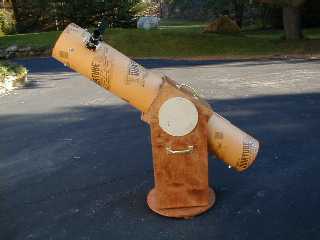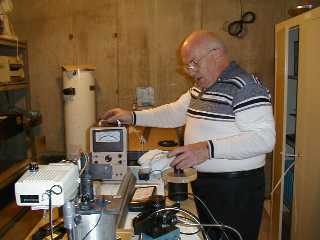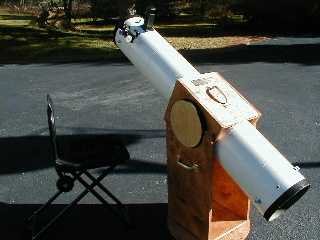Ed Grinds A Mirror And Makes a Telescope: A Serial Article (Conclusion)
By Ed Ting Latest Installment: 11/13/00Chapter Nine: Ed Builds a Telescope I have decided to make a Dobsonian mount around my mirror. Gathering the parts took a couple of weeks. I decided to splurge a bit and ordered a 5' X 5' sheet of Baltic Birch plywood instead of settling with the commercial- grade stuff. Here, I was more in my element, as I knew exactly what kind of mount I wanted. I was also able to draw upon my experience from having tested so many telescopes over the years. My priorities were: smooth motions on the axes, light weight, and a low rocker box for use while seated. As time went on, aesthetics began to rise in importance as well. Copying plans from Richard Berry's Build Your Own Telescope and Starmaster's excellent 7" Oak Classic, I came up with a design. A 1.25" focuser, aluminium mirror cell, 1.52" secondary/spider, and several Sonotubes were purchased. The azimuth axis is teflon on formica, while the altitude axis is teflon on velcro, like on the Starmaster ELs (see, I do learn something once in a while!) What I did can be duplicated using a good router, table saw, and electric drill. The altitude bearings are oversized at 8", and I used an 8" diameter Sonotube. Those #$!@#% Sontubes caused me all sorts of heartache - they come with an annoying waxy coating on the exterior, don't drill cleanly enough, and flex a bit in dewy weather. Otherwise, assembly went smoothly, if a bit more slowly than I wanted. I had to wait between the four coats of stain I applied, and then again with the three coats of varnish. Anyone who has ever started a woodworking project can sympathize with how many times I wound up going back (and back, and back) to the hardware store to get that "last" item I needed.
 An early mock-up, put together
to test collimation and balance
An early mock-up, put together
to test collimation and balanceSidebar 1: What did all this cost? Many of you have been asking how much this telescope project cost. I kept track of my expenses and it breaks down something like this: Mirror blanks, pitch, grits, $49 Mirror cell, secondary, focuser, $172 One 5' X 5' sheet of Baltic Birch plywood, $29 Misc hardware, Sonotubes, stain/varnish, etc, $93 If you want, add in another $37 or so for stuff I bought but never used, stuff I bought twice due to drilling/cutting errors, etc. $343-$380 plus six month's labor doesn't make for a very cost efficient project, but cost was not the reason for doing this in the first place.
Sidebar 2: The Grinding Guru Revealed Ed Dougherty has been making telescopes longer than many of us have been alive. His steady, guiding hand and dry humor kept us on our toes throughout the past six months. During this time, he drove nearly 60 miles to make these meetings every other Sunday. We're indebted to him.
 Doing what comes naturally:
Ed D at the Foucault Tester
Doing what comes naturally:
Ed D at the Foucault TesterConclusion Many older astronomers sadly lament that mirror grinding is a dying art. Why spend hours of time over several months on a monotonous task when you can order an entire telescope through the mail for about $350? What's more, machines now manufacture these mirrors with little or no effort on the part of a human operator at all, and at minimal cost. As the months progressed on this project, I can admit I felt the same way many times. This was a boring task. Yet hundreds of you from all around the world wrote in during the past six months, offering words of advice or encouragement. Many of you wrote to tell me how "exciting" all of this sounded, which was a pleasant surprise to me, since "exciting" is not a word I would use to describe such a lengthy, repetitive task. In fact, there was a time, around the 120 grit, that I seriously considered abandoning the project altogether. Between working a full-time job, being president of my astronomy club, and running the rest of Scopereviews, this mirror project was one I began to regret starting. At times, only your kind and enthusiastic letters kept me going. I would have quit more than once were it not for your overwhelmingly positive response to this article these past few months. So, in a way, this is really our telescope - yours and mine.
 The completed telescope, Nov 11, 2000
The completed telescope, Nov 11, 2000